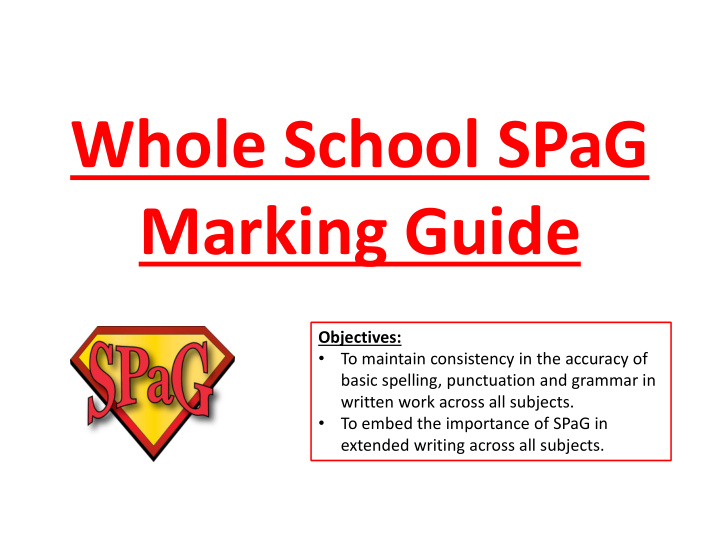



Whole School SPaG Marking Guide Objectives: • To maintain consistency in the accuracy of basic spelling, punctuation and grammar in written work across all subjects. • To embed the importance of SPaG in extended writing across all subjects.
General Marking Guide Look out for these SPaG errors in all written work: What to Look For Annotation Capital Capital letters should only be Circle the incorrect use of a lower Letters used for: case letter (when it should be a Beginning of sentences capital) and vice versa. Names of people or places Names of days and months Put CL (capital letter) in the (not seasons) For the word ‘I’ margin. Titles Initials
General Marking Guide Look out for these SPaG errors in all written work: What to Look For Annotation Apostrophes Apostrophes should only be used Circle the incorrect use of an apostrophe or the whole word if it is for: missing an apostrophe. Contractions, to show that a letter has been missed out Put a P (punctuation) in the margin. (don’t, I’ve) Possession, to show that something belongs to someone (the teacher’s chair) It’s = it is Its = belonging to it Apostrophes should not be used for plurals.
General Marking Guide Look out for these SPaG errors in all written work: What to Look For Annotation Spellings Identify any incorrectly spelt words in Underline the word that is spelt the students’ work. incorrectly. If there are many errors, focus on 3 Put SP (spelling) in the margin. words per piece of work . These may be subject specific terms or The student should be able to use a key words for the topic. dictionary to find the correct spelling and write it out 3 times. For students with dyslexia, and for words with difficult beginnings, teachers may need to correct the spelling or give the first few letters.
Extended Writing Marking Guide Give a SPaG mark out of 4 for all extended writing (a paragraph or longer): SPaG Criteria (Exam Board) Pupil-Friendly Language Mark 4 Learners spell and punctuate with My spelling and punctuation is always accurate. • consistent accuracy. My sentences all make sense. My grammar is • Learners use rules of grammar with always correct. effective control of meaning overall. I can use a wide range of terminology Learners use a wide range of specialist terms appropriate to the task. as appropriate. 3 Learners spell and punctuate with My spelling and punctuation is mostly accurate. • considerable accuracy. My sentences generally make sense. My • Learners use rules of grammar with grammar is usually correct. general control of meaning overall. I can use some terminology appropriate to the Learners use a good range of specialist terms task. as appropriate.
Extended Writing Marking Guide Give a SPaG mark out of 4 for all extended writing (a paragraph or longer): SPaG Criteria (Exam Board) Pupil-Friendly Language Mark 2 • Learners spell and punctuate with My spelling and punctuation is sometimes reasonable accuracy. accurate. Learners use rules of grammar with some My sentences don’t always make sense, but you • control of meaning and any errors do not can still understand what I am trying to say. significantly hinder meaning overall. I need to use appropriate terminology in my Learners use a limited range of specialist terms work. as appropriate. 1 The learner writes nothing. I haven’t written anything. • The learner’s response does not relate to I need to relate my ideas to the question. • the question. My spelling, punctuation and grammar errors The learner’s achievement in SPaG does not mean that it is hard to understand what I am reach the threshold performance level, for trying to say. example errors in spelling, punctuation and grammar severely hinder meaning.
Moving Forward • Please take a ‘Whole School SPaG Marking Guide’ for your blue folders. • A3 laminated copies will be delivered to your classrooms by Literacy Ambassadors this week. • Literacy Spotlight will be capital letters – starters and activities delivered during Tuesday morning briefing.
Recommend
More recommend